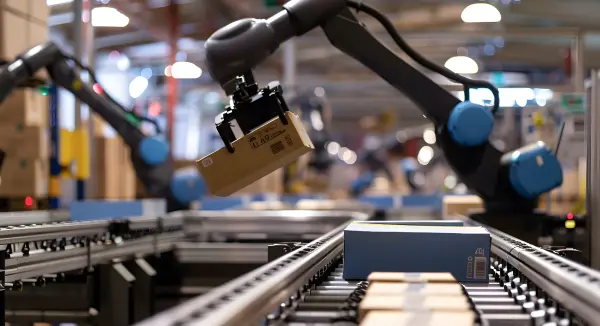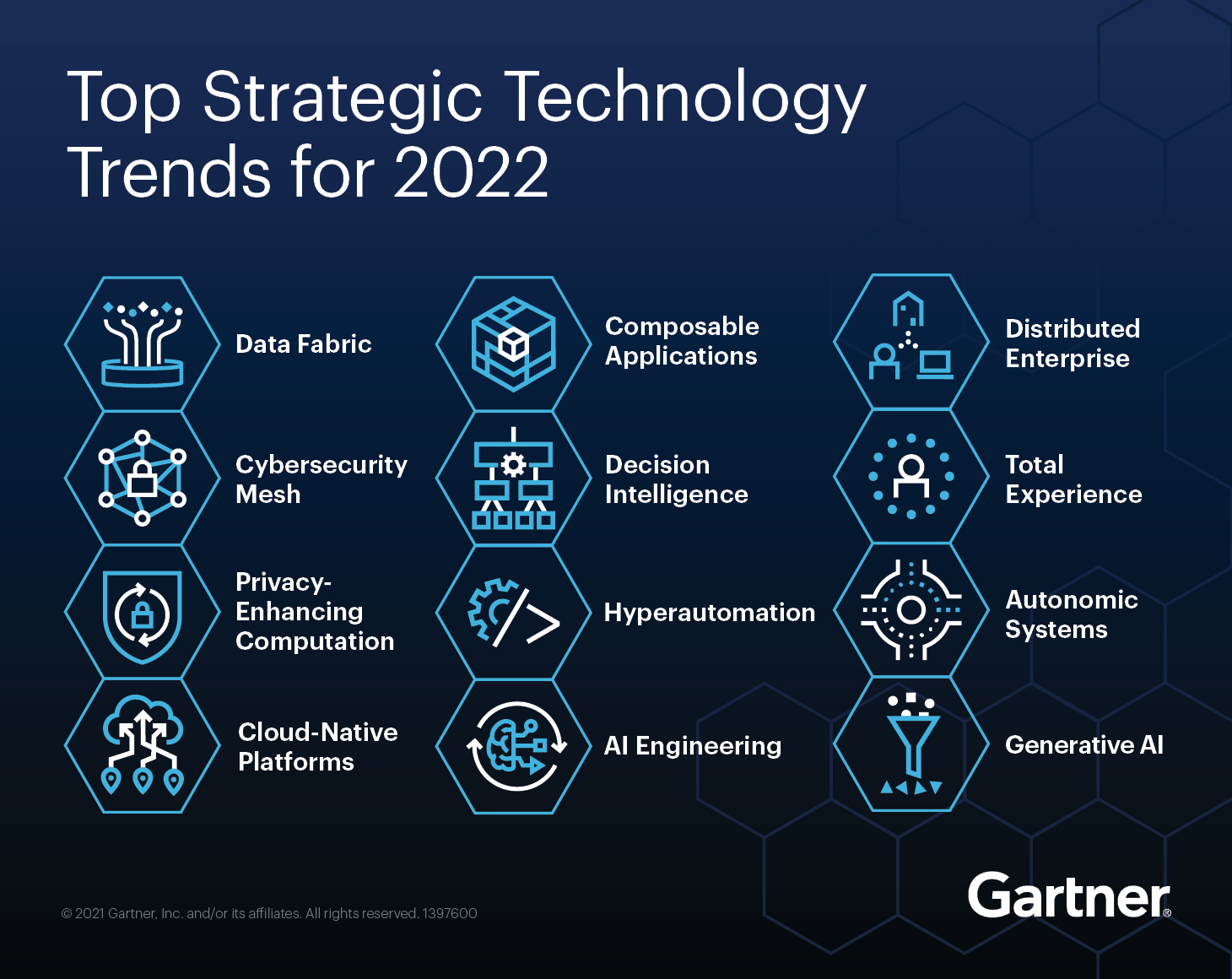
- Innovation
2021 was a year full of complex challenges, which made us reflect deeply. Through technology, society has followed a new path of development, expanding borders and improving processes and systems. Now, it is time to anticipate the next steps and to build new strategies. To inspire you, we will share the highlights extracted from the Gartner Top Strategic Technology Trends for 2022 report, which outlines 12 trends that will shape the future of digital business. They allow for three main outcomes:
Engineering Trust: the creation of a more resilient and efficient IT foundation, capable of ensuring that data is integrated and processed more securely;
Sculpting Change: the development of creative solutions to scale and accelerate the digitalization of organizations. With a faster feedback loop, it becomes easier to automate activities, optimize Artificial Intelligence (AI) and enable more efficient decision-making;
Accelerating Growth: joining forces in IT will gain significant space in business and in the market. These trends drive value creation and enhance digital capabilities.

Tech trends for 2022. Source: https://www.gartner.com/en/information-technology/insights/top-technology-trends.
The importance of data is increasingly clear in the business world. However, its use remains isolated within applications, which can result in a reduction of its potential. To resolve this issue, there is Data Fabric – a flexible and resilient integration of data sources across platforms and users.
Its main function is to learn through analysis, its objective is to recommend where the data should be used or how it should be changed, enabling the creation of a more integrated data mesh. In addition to being one of the top tech trends for 2022, this architecture promises to reduce data management efforts by up to 70%.
This trend was part of the Gartner report for 2021 and remains an important strategy for 2022, as a large part of digital business assets continue to be distributed in the cloud and in data processing centers. Bearing in mind that more traditional and segmented security actions can leave organizations exposed to breaches, it is essential to invest in a more flexible cybersecurity mesh, with the ability to integrate between different services.
The Cybersecurity Mesh protects assets regardless of location and enables a holistic approach that extends across the entire IT service base. Furthermore, it makes the identity verification process faster and more reliable.
“By 2024, organizations that adopt a cybersecurity mesh architecture will reduce the financial impact of individual security incidents by approximately 90%.” (Gartner)
The real value of data lies in the interpretation and the way in which the information is used to create Artificial Intelligence (AI) insights and analysis. However, with the creation of the GDPR and LGPD (Brazilian General Personal Data Protection Law) and with the growing concern of users regarding their data, it has become essential to improve security requirements when processing personal information, especially in untrusted environments.
With that in mind, Privacy-Enhancing Computation enables the use of a wide variety of protection techniques – which allow extracting only what is really necessary from general data, meeting compliance requirements. Through encryption and pre-processing approaches, sensitive data can be shared across ecosystems, creating value and preserving privacy. This is one of the tech trends for 2022 that was also featured in the Gartner report for 2021.
Cloud-Native Platforms are technologies that allow you to build more resilient and agile application architectures – capable of responding to rapid digital market changes. Cloud-Native Platforms improve the process of migrating work that was not designed for the cloud, reducing infrastructure facilities and expanding functionality development time for applications.
“In 2025, Cloud-Native Platforms will serve as the foundation for more than 95% of new digital initiatives.” (Gartner).
Multidisciplinary teams can face many challenges throughout the development of a project, such as low programming knowledge, limited technologies, and the need to deliver on tight deadlines.
To solve this scenario, there are composable applications, developed from modular components with a focus on business. Composable applications make it easier to use and reuse code, accelerating the time to market for the digital product or service, releasing enterprise value.
Decision Intelligence is among the top tech trends for 2022. This approach’s mission is to facilitate organizational decision-making, making use of a set of processes that rely on intelligence and data analysis.
We know that decisions are influenced by a multitude of factors. However, we live in a world of constant evolution and technological transformation. Therefore, organizations need to be increasingly prepared for quick and effective decision-making.
Decision Intelligence can also enhance the automation of the human decision process through Artificial Intelligence. The result is a multidisciplinary team capable of managing, evaluating, and improving decisions based on learning and feedback.
Hyperautomation is an approach that seeks to make the business model more agile, by identifying, examining, and automating as many IT processes as possible. Hyperautomation requires the orchestrated use of a set of technology tools, including Low-Code and RPA (Robotic Process Automation) platforms.
This trend has already been mentioned in the 2020 and 2021 Gartner reports, remaining an irreversible and fundamental strategy for the growth and scalability of digital products and services.
“By 2024, spending on hyperautomation will increase 40-fold, making adaptive governance a differentiating factor in corporate performance.” (Gartner).
Artificial Intelligence is much more than a technology trend for 2022. Moreover, it is the path that allows us to come out of the Covid-19 pandemic with stronger and more consistent businesses. Through AI Engineering, it is possible to automate updates of data, models, and applications, making processes more agile.
This strategy has already appeared in the Gartner report for 2021 and suggests that organizations optimize AI using integrated data and models capable of delivering business value. Artificial Intelligence Engineering combines automated updates with governance, ensuring increased performance.
“By 2025, 10% of companies that establish AI engineering best practices will generate at least three times as much value as the 90% of companies that do not.” (Gartner).
The popularization of remote work is one of the cultural changes arising from the Covid-19 pandemic. This working model resulted in more distributed enterprises that prioritize the virtual environment (remote-first), focusing on digitalizing the touchpoints between partners and consumers.
Distributed enterprises are able to better serve the needs of their stakeholders, who are increasingly looking for digital services and hybrid workplaces. As a result, professionals work more flexibly, while consumers are increasingly unavailable through traditional physical routes.
“By 2023, 75% of organizations exploring the benefits of Distributed Enterprises will have 25% faster revenue growth than their competitors.” (Gartner)
This business strategy accelerates growth as it integrates the experiences of employees, customers, and users, generating more trust, satisfaction, and loyalty. Moreover, through the holistic management of the experiences of multiple stakeholders, it is possible to promote knowledge sharing.
When everyone has a leading role, the feeling of responsibility is greater and this results in engagement and high performance. It is for this reason that this technology trend was also present in the 2021 report.
“By 2026, 60% of large enterprises will use Total Experience to transform their business models.” (Gartner).
Traditional manual management can no longer keep pace with the growth of contemporary organizations. This is why self-managed autonomous systems that learn from the environment are so highly valued in the market.
These physical or software systems modify their own algorithms in real-time, creating a set of technology resources capable of supporting new requirements and situations. In addition to optimizing performance and defending attacks without the need for human intervention.
A company that uses this technology trend very well is Ericsson, which manages thousands of cell phone antennas in complex environments. Its autonomic systems use machine learning to optimize 5G network performance, for example.
Generative Artificial Intelligence is a form of AI that learns from sample data. It is capable of generating new and realistic artifacts similar to the original data, but without copying them. This allows generative AI to be an innovation engine for companies, accelerating R&D cycles in fields ranging from medicine to product creation.
“By 2025, Generative AI will account for 10% of all data produced.” (Gartner).
These tech trends for 2022 have the potential to contribute to economic recovery. Over the last two years, we have lived in a scenario of instability due to the constant transformations of the Covid-19 pandemic.
However, the technology sector has gained even more prominence by contributing to the digitalization of business and the acceleration of studies and research. We are more connected and globalized than ever and the impacts of this expansion are already being felt in companies and society as a whole.
We developed new skills, tested new work models, and expanded borders in search of internationalization. We transformed the world through technology, which will increasingly unite humans and robots in favor of evolution. Get ready because the future has already begun.